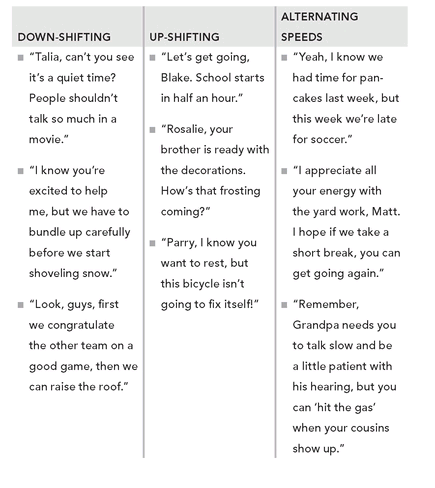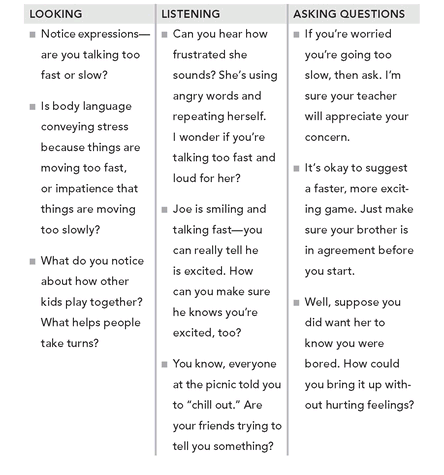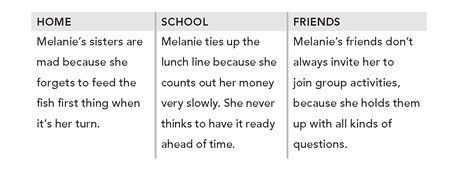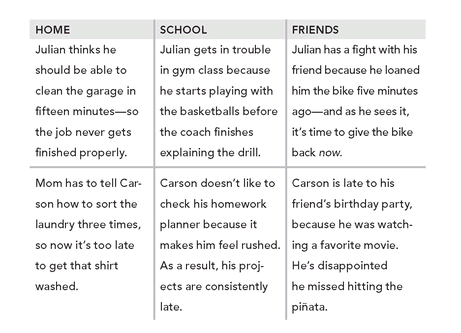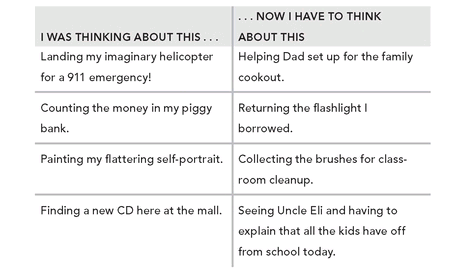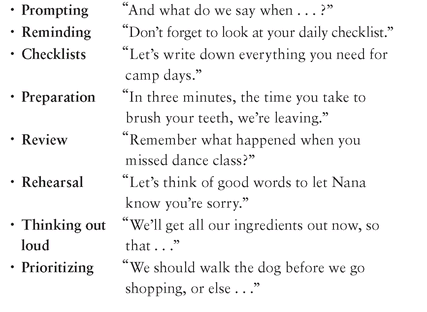CHAPTER 4
Pillar II
Changing Channels and Shifting Gears: The Advantages of Flexible Thinking
Whether it’s reacting to a family crisis, a change in plans, or a series of interruptions, an adaptive mind is able to flex. A flexible mind can shift attention and tempo to handle an interruption, kick into a “higher gear” when required, or slow down and focus inwardly when the occasion merits serious reflection. Expressions such as “you’ve got to react,” “think on your feet,” or “go with the flow” are folk wisdom about the valuable role of flexible thinking.
Adapting to the changes around us, shifting focus and tempo as needed, is fundamental to participation in our highly social, interactive world. Think about how you would be perceived at work, with friends, or in your family if you moved at only one pace, or if you had only a limited scope of interest. The same kind of tension emerges among children early in life as they pick up on cues about the need to be flexible. However, for some kids, adapting to change is anything but easy, particularly those whose nature calls them to follow their own rhythms and patterns of interest. This chapter will help you to assess flexibility in your own child, and guide you in helping kids past the primary impediments to flexibility. Our discussion will highlight how flexible thinking contributes to the social capability of children (social attunement) in addition to helping with practical aspects of situational problem-solving.
Social attunement implies an ability to sense the nearly constant exchange of verbal and nonverbal information between people. One moment we’re making focused eye contact with a close friend, discussing something important, and the next moment we’re joined by two other friends, one of whom tells a joke, causing the group to erupt in laughter. Social transitions also entail moving from one situation to another. A flexible mind shifts through these transitions like a commuter, sometimes traveling in the high-speed lane, sometimes working through stop-and-go traffic, and sometimes devising a detour to get around unforeseen circumstances. Mostly, we make these shifts automatically, rarely giving them a second thought. While Factor Ex is still in development, however, transitions might not come as easily. Maybe your daughter doesn’t like it when your play together is interrupted by a ringing telephone, and matches her annoyance with a shrill yell. Maybe your son can’t accept a change in vacation plans, threatening to run away if the family doesn’t go to Six Flags. Unfortunately, the stress of a change in circumstance is probably especially difficult for you, having to referee and mitigate “meltdowns” in kids who don’t easily change channels—break with an anticipated routine.
Consider a few more common examples of how inflexibility might become a personal, social, or academic liability:
Eleven-year-old Karen insists on confronting a child who pushed her younger brother. Karen’s done this before; she stands nose to nose with the perpetrator, uses abrasive words, and generally escalates the situation into something it should have never become. Despite her mother’s pleas that she “ignore the situation,” Karen says, “No way, that kid insulted us and he’s going to pay.”
Why is Karen so insistent on a course of action that makes things worse? Why does she personalize what happened to someone else? And why is it so hard for Karen to see that there are other possible approaches to resolving the problem?
Neil is a senior in high school. Unlike parents who may worry that their child doesn’t read enough, his parents worry about his intense preoccupation with books. Neil becomes so caught up in what he’s reading, he usually seems oblivious to those around him. Peers have started to ignore him, quietly referring to him as the “book droid.” Neil’s teachers see a bright academic future for him, but his parents anxiously foresee a life of loneliness if Neil can’t learn to shift his focus—at least occasionally.
Does Neil care what others think? Why doesn’t he sense the type of signals he sends to others? How could he be helped to be more flexible in his focus? How can his parents help him expand his interests without totally discouraging him from reading? What could potentially grease the wheels of this type of change for Neil?
Ben is a third-grader who really enjoys school. His teacher’s only concern is his trouble “down-shifting” after recess. Basically, Ben wants to continue speaking loudly and moving his body with the speed and spontaneity more appropriate to the playground than a classroom. As a consequence, Ben often disrupts class and is scolded. He looks stunned when he receives these reprimands, his feelings clearly hurt.
Doesn’t Ben understand that when recess is over, it’s time to calm down—to “down-shift”? Why can’t he see how his behavior affects other students and his teacher? Is this a sign Ben may have ADHD? What could help Ben shift tempo?
These questions reflect the common concerns we have about kids who struggle with some type of inflexibility. We will review strategies for coping with these challenges, but first let’s consider the concept of a flexible mind in more detail.
Can Flexible Thinking Actually Be Measured?
Psychologists measure the executive pillar of flexible thinking with very specific tests. These tests require a person to adapt to various “rule” changes. For example, a child is presented with a page containing a random arrangement of all the letters in the alphabet and many numbers. He is asked to connect the letters in sequence beginning with “A,” while ignoring the numbers. No sooner has he finished that test than he is given another in which his task is to connect the numbers sequentially while ignoring the letters. A moment later he is given a third test, this time asking him to alternate between connecting letters and numbers, maintaining the sequence for both. For example, connect A—1—B —2—C—3, etc. Simple, right? Well, not exactly. These are timed tests and a person’s score depends on how quickly his mind can wrap itself around a new set of rules, while maintaining accuracy.
Another mentally strenuous way that flexible thinking is measured is the classic Stroop Color Word Test. In this test, a child is presented with a series of words printed in different color inks and is asked to say the ink color of each word as fast as possible. Here’s the catch—the words are names of colors that aren’t the same as the color ink they are printed with. For example, the child sees the word red but it is printed in blue ink. The challenge is to block “interference”—the name of the color—while attending closely and rapidly to ink color. Almost everyone heaves a sigh of relief when the test is over. It can be mentally exhausting, because it requires the brain to wrangle with competing streams of information. Even for adults, this sort of challenge can try our patience. Yet the type of acumen that helps us do well on this test is related to dealing effectively with various basic life challenges. For example, performing well on the Stroop test suggests you are less likely to fall for a “trick answer” on a multiple-choice exam, that you can remain focused on the actual cost of a car in the midst of an emotional sales pitch in the auto showroom, or that you can remember the point you want to make in a debate despite the verbal interference of your opponent.
As you might detect, clinical measures of flexible thinking involve a nearly unavoidable degree of abstraction. While it’s impossible to re-create in a psychologist’s office the complex transitions that occur in a child’s life, tests like these provide a snapshot of a child’s “real-life” capacity for flexible thinking. Interestingly, performance on these tests often predicts a person’s degree of creativity, at least in the sense of being able to think of “alternate uses” for common objects (like knowing that an old barn door could be converted into a handsome antique tabletop). Creativity tests that seek to detect a person’s capacity for novel (“alternative”) thinking are tapping into the power of Factor Ex, and especially the pillar of flexibility.
Flexible Thinking and Creativity
Factor Ex enhances a person’s creativity, at least in the sense of generating novel approaches to common situations. In some countries, the development of this attribute is taken quite seriously, and children are now provided with formal training in how to think creatively. For example, in Asia many children attend what might aptly be described as creativity clinics. In essence, these are classes where children are drilled in adaptive, flexible thinking. Such schools raise an important question: Can innovative, creative thinking be taught—and to what extent? Although that question is still largely unanswered, it bears consideration given the broad implications for flexibility. Do you prefer to have relationships with people who have lots of ideas? Is it easier to work through a problem with a spouse, colleague, or friend who can see things from more than one perspective? Bottom line: Creative minds generally find it easier to bend and flex, making life with others at least a little easier.
Hurry Up, Slow Down, Hurry Up, Slow... Changing Gears for Life’s Rhythms
Let’s consider flexibility with respect to changes in tempo. We need to understand the challenges of “down-shifting” (slowing down thinking and behavior), as well as “up-shifting” (the ability to accelerate) when they fit the situation. The examples that follow will help you identify whether or not your child may have some difficulty with these types of rhythmic shifts. Like all the executive pillars, a child’s ability to be flexible should be considered with respect to age. While a five-year-old might have trouble speeding up if you’re late for an appointment, a twelve-year-old should be able to at least make a valiant attempt at acceleration. (For the sake of discussion, we’ll assume that there are no other underlying reasons, such as passive-aggressive behavior, causing a child to stall.) Along with your observation of a child in comparison with peers, these examples should help you know a child’s needs better.
CHILDREN STRUGGLE WITH DIFFERENT TYPES OF TEMPO CHANGE
Our Brains Have a “Gear Shift”
Did you know that neuroscientists have identified the part of the brain, located in the prefrontal cortex, that is responsible for helping the brain to shift gears? The anterior cingulate extends across the prefrontal cortex and plays a critical role in enabling the brain to shift gears—the essence of responding to changes in tempo. It’s great to know where executive thinking lives in the brain. Too bad it’s not helpful to tell kids, “Your anterior cingulate is ignoring me.” Read on for more practical ways to put this important part of the brain into gear.
Managing Social Tempo
Notably, social skills training often includes increasing sensitivity to aspects of interpersonal communication that help people connect, including conversational pace. Matching the pace of someone you are in conversation with is an excellent way to project empathy—to help that person feel connected to you through your consideration of her tempo. Have you ever felt annoyed with someone who doesn’t allow you time to answer his question before firing off the next one? Or conversely, been irritated with someone who replies to an urgent query with a meandering monologue—“I know you’re fed up with having to solve everyone’s problems, but please, where’s the fire extinguisher?” Unfortunately, when children don’t sense and respond to the pace of others, they often appear indifferent, rude, or even unintelligent—a major liability where making friends is a concern.
Yet it’s a mistake to confuse a person who is self-absorbed with one who is self-centered. A person who is self-centered cares very little about others and might even be described as egotistical. In contrast, a child who is self-absorbed is one so caught up in his own thoughts and personal fascinations that he has difficulty tracking what is happening in the minds of other people. When I lead social skills groups, I see this phenomenon frequently, and it sometimes leads to hard feelings. For example, it’s hard for one child to understand why peers aren’t as fascinated with NASCAR as he is. His mind is absorbed for hours each day by fantasies of becoming a race car driver, and as a result, he unintentionally tunes out other people’s interests. As you might imagine, this doesn’t sit well with peers, who are equally invested in their own interests—like one boy who suggested all race car tracks be converted to lacrosse stadiums, where “the public could finally appreciate what a great sport it is.”
SELF-ABSORBED OR SELF-CENTERED?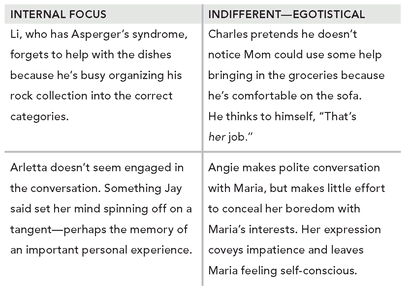
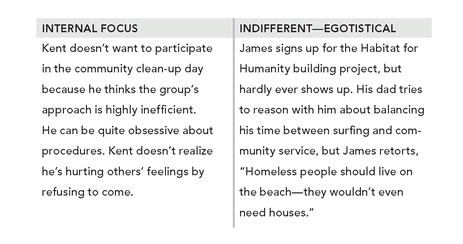
Seen from the outside, a child who is self-absorbed may unfortunately look very similar to one who is self-centered. This very fact makes the capability of social attunement a critical step in childhood. Children need to be aware of how they are perceived by others if they are to avoid having others misinterpret their attitudes. Sometimes, parents provide this guidance verbally: “Trent, please slow it down. Nan can’t write that fast. How do you think this tempo is making her feel?” At other times we may need to make our point visually. A favorite technique of mine is to hold up a mirror to a child who has a very self-absorbed expression and ask him, “What kind of person do you see?” As children study their own expression, they often realize more about how they appear to other people and what signals they send with respect to friendship. “I know you say nobody wants to be your friend, but I wonder if you’re showing other kids what you really want to say—that you really are interested in getting to know them.”
Is an Inflexible Tempo a Social Liability? • Conversational pace. A child who struggles to keep up with the exchange of information in a conversation may feel “out of the loop.” In contrast, kids who speak rapidly may lose others who can’t or won’t keep up with the barrage of information.
• Allowing eye contact to linger. No one likes to be stared at intently, but we do need to receive enough eye contact to know we have been heard—that our presence is important to others. Kids who don’t easily down-shift can become impatient, or even insensitive, to this basic social skill.
• Taking time to listen. Along with providing good eye contact is the need to balance speaking with listening. Talking nonstop may unintentionally and unfortunately convey “I’m on stage and you’re the audience.” Peers with healthy self-esteem won’t stand for this behavior for very long.
Pointing children toward the realm of social cues can be a substantial challenge, especially with kids who are preoccupied with the contents of their own minds. Children diagnosed with pervasive developmental disorders are a good example. Asking a child with autism or Asperger’s syndrome to track the tempo of others can seem like an illogical imposition to them, one they may even find irritating. Yet learning to sense and match social tempo is a practical pathway toward social connection, a fundamental need for a child with Asperger’s syndrome. Coaching these skills with a special needs child is a long-term commitment, often extending into early adulthood. Regardless of your child’s developmental level, he or she will benefit from some basic approaches to reinforcing an awareness of social tempo.
APPROACHES TO COACHING SOCIAL TEMPO
What’s the Speed of Thought?
Think fast—how should you respond if your friends throw a surprise party for you? Would you know what to say and how to act? A person’s “processing speed”—how fast a person can recall or bring to mind basic facts, things that they already know—makes a significant contribution to her capacity for adaptive, flexible thinking. (One of the psychological tests used to assess processing speed requires a child to rapidly name pictures of familiar objects. It is not a test of whether she or he can name a car, flower, clock, cat, etc.—that much is assumed—but instead is a measure of how quickly a child can bring those words to mind.) Although processing speed tends to correlate with IQ, kids with learning challenges often have a slower processing speed in specific areas (e.g., reading or expressive language). What’s important for us to bear in mind is that processing speed enables working memory (see Chapter 7) to do its job well, and helps facilitate transitions between one time frame and another. As you may have experienced, one of the key challenges in parenting young children is contending with colliding time frames. For example, an adult’s expectation for how long it should take a child to transition from drawing with crayons to washing his hands and getting his coat on may be markedly different from how long a child thinks it should take for that same activity to occur.
Colliding time frames are a leading cause of family stress. Increasing flexibility may not totally eliminate tempo differences, but it can aid in developing an appreciation that not everyone wants to move at the same speed
. Here are a few examples of how and where colliding time frames may become problematic:
Help Prepare for Transitions
Almost without fail, colliding time frames lead to conflict, exacerbated by our general shortage of time and ever-increasing “to do” lists. Adults can minimize the emotional impact of tempo differences by helping children to mentally anticipate transitions. The simplest preparation for transitions is to announce that they will occur. Ideally, such announcements are provided several times, and well in advance of the transition. Doing so gives children fair opportunity to adjust their thinking—to look outside their personal, physical, and focal space to consider the needs and actions of others. Some kids particularly enjoy it when you make transitions playfully competitive. “I bet there’s no way you could get dressed for school before I finish making the oatmeal!” In this way, the challenge is framed as an element of mastery, and consequently, as a prospective source of positive recognition. When you can integrate cartoon figures or action heroes, thinking flexibly can be fastened to a favorite icon or role model. If your children watch television, you might try to notice some good examples of how their favorite characters change tempo to use for future reference. “Look how fast Superman can change clothes.”
Please remember, our goal is not to hurry children along so we have time to do one more errand. Instead, we want to encourage flexible thinking as a path to capability. Whether being attuned to the pace or focus of others, multitasking, or purposefully acting to achieve a particular goal, these capabilities are a foundation for confidence, especially as the lives of kids intersect with family, school, and community.
Tone Plays a Big Role in Coaching Tempo
Ask yourself, is it harder to gear up for the pace of work if you’ve just had an argument with your friend? Or perhaps you get a irritated when your significant other asks you to “hurry up” without regard for the difficulty or personal importance of a particular task? By extension, how we approach facilitating tempo changes in kids has a major impact on whether or not a power struggle ensues. When transitions are announced abruptly or forced, the likelihood of conflict is increased. When children have not had time to mentally reframe a situation, and are forced to forgo their own personal tempo for that of someone else, it can feel like adults are pulling rank. Few of us enjoy subordinating personal interests for the sake of someone else’s. Of course, as adults, we are called upon to assert priorities with respect to tempo, but there is always latitude in how we go about doing this. “Craig, have a good time playing up in the tree for five more minutes, then we have to get ready for the restaurant. Don’t worry, I’ll give you a one-minute warning,” is better than, “Craig, honey, we gotta go. Get down from there now, please.”
Help Children to “See” Time Going By
It’s helpful to give children a way to visualize the space of time when we want them to think and act more flexibly. As we saw in previous chapters, asking your five-year-old to “be ready in fifteen minutes” has little value if he can’t yet conceptualize quantities of time. There are now some highly innovative products that help children translate time into something more tangible and, as a result, more manageable. A favorite product of mine is called the Time Timer (see Helpful Resources), essentially an oversized sixty-minute timer that can be set for any desired quantity of minutes. The special feature of this timer is that a span of bright red appears on the timer’s face when the timer is set, gradually disappearing as time elapses. A child’s quick glance is enough to detect how much time is left—and it can be set up on a shelf out of the reach of tinkering hands. A relatively small slice of red suggests, “Time to step on the gas!” Timers can be useful in helping kids break down time into clear chunks. It is better to restart the timer as one step is completed than try to get away with setting the timer for a longer span and hoping kids will make subtransitions by themselves. For those parenting young children, this may mean a couple more trips up the stairs, out to the yard, or into the bathroom, but it may be well worth it to eliminate energy-consuming power struggles.
Over Here, No, Over Here, Hey, Over Here . . . Learning to Change Channels
Beyond the difficulties of changing tempo, there are times when a person’s focal point also needs to shift. Personal experience tells us it’s easier to make this type of shift when the decision to shift focus is a product of our own will. Shifting focus is harder when required by someone or something else. Kids who become engrossed in an activity will surely resent being pulled out of that reality to focus elsewhere—even when it’s for something as commonplace as lunch, school, or bedtime.
Families encounter two distinct types of flexibility challenges where focus is concerned: two-point and three-point focal shifts. A two-point shift simply implies shifting one’s focus from one point to another. Children are almost continually required to make this type of transition, both at home and school, balancing their personal interests with the demands made by others. Here are a few examples of two-point transitions:
TWO-POINT TRANSITIONS IN FOCUS
To make matters a little more complex, children are also required to complete three-point transitions; a person must shift from one point to another, and then back to the original focus point. Sometimes, the second point of focus in a three-point transition is some form of distraction. The challenge for a distracted child is to return to her or his focal priority, despite being mentally pulled off-task. Practically speaking, this is the way we live—distractions are a part of life. Some might argue that such diversions even make life more stimulating. However, that is only so when a person has a sense of self-control, which is to say that he has one hand on the “gear-shift,” consciously deciding where to direct his attention. Three-point transitions are particularly dependent on working memory, because a child has to keep important information on her or his mental clipboard for varying amounts of time. A three-point transition could occur in as little as a few seconds or as long as a few minutes, as follows:
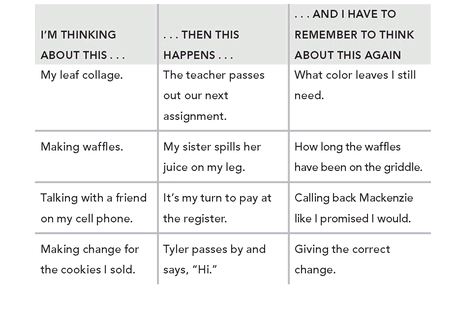
THREE-POINT TRANSITIONS IN FOCUS
Surrogate Executive Control
The key to making successful transitions is maintaining awareness of multiple focal points and their respective hierarchy. This is an understandably difficult skill for kids driven by the pursuit of stimulation. Learning to suppress this instinct in the service of a flexible mind is a substantial learning curve for most children, yet is a fundamental aspect of self-regulation and, ultimately, capability. Surrogate executive control, provided by thoughtful adults, is the best way of coaching this type of skill. This important term refers to a broad constellation of strategies parents and teachers can use to activate Factor Ex.
Basic Types of Surrogate Executive Control
Notice that these statements tend to use we, and refer to interactive tasks. All children, and particularly those with learning challenges, gain strength and momentum from helping relationships that are expressed collaboratively.
Using Play to Strengthen Flexible Thinking
It has often been said that play is the work of children. Play provides an ideal context in which to build adaptive, flexible thinking skills. Games, especially, get Factor Ex working as children focus on, and problem-solve, various tasks. There are many ways adults can use play to enhance flexible thinking—let your own imagination be your guide. Here are a few suggestions:
Building Emotional FlexibilityGAME: Using a hand puppet and a silly voice, have the puppet act friendly and happy, then get a little grumpy or act mischievous. In your own voice, suggest, “Looks like Fuzzy needs cheering up. Can you help him?” or “Uh-oh, it looks like Fuzzy is not behaving. Can you tell him the right thing to do?” (Children like it if the puppet won’t behave for you but will for the child.) Most kids have fun exploring the different styles of interaction.
Helping Three-Point TransitionsGAME: Invite your child to play the “Double-Game Challenge.” The task is to play two games simultaneously, such as tic-tac-toe and hangman, or checkers and Yahtzee, switching back and forth between games whenever a one-minute hourglass runs out. Your child scores points for remembering whose turn it was and what the last move was; offer a good prize to motivate. (Games that rely on working memory, such as [obviously] memory or chess, also help with transitioning skills.)
Learning to Up-Shift and Down-ShiftGAMES: Red-light, green-light (where children must freeze or move according to instructions), or hide-and-go-seek (where they must run quickly, and then hide, silently and quietly), teach how to change tempo. Any game that requires taking turns, transitioning active time with observation time, helps children learn about changes in pace.
Developing Creative ThinkingACTIVITIES: Arts and crafts are good ways to teach children about using materials in unconventional ways. (That macaroni necklace serves a purpose!) Older children may enjoy visiting an art studio or museum to look at work made of found objects. At the Rhode Island School of Design, fashion students had an assignment to create couture out of unusual items. Imagine a dress crafted from DVDs, or a suit made of woven rubber bands. Ask your child to make something wearable out of a common household item, or find a creative way to recycle a household object for an alternative use.
Fear of Change
We’ve been talking about changing the tempo and focus of thinking, yet emotion plays a big role in making cognitive flexibility possible. More specifically, inflexibility is one way that some children cope with anxiety. Children who are prone to anxiety often rely heavily on structure and routine. For these kids, changes in routine—encountering the unfamiliar—raises anxiety. If Ella doesn’t want to sleep over at Grandma’s, it may be that she doesn’t know if she can ask Grandma for help with her homework. If Lonnie won’t try going to a new park, it may be because he’s uncertain if dogs have to be kept on leashes there—as they did in the old park. None of us are eager for more anxiety in our lives, especially the youngest of us, who have had the least amount of experience managing transition-related anxiety. Put simply, transitional anxiety is often related to not knowing what to expect, what to do, or how to do it. With respect to special needs kids, this is an important concern that warrants extra attention. Although parents may be accustomed to the idea of a specific learning disability, as in the case of reading or math delays, we unnecessarily limit our understanding of learning challenges when we limit ourselves to academic hurdles. In our evolving world, learning to “change channels” is arguably as important as any other learning skill.
The learning curve for flexible thinking is accelerated when structure and routine are consistently provided. This minimizes anxiety about change and makes it a more manageable thought process. Perhaps you can write a list of steps for making a particular transition, or review how to make transitions at a time when everybody is relaxed. Parents can be reinforcing and encouraging about things a child does well, while also raising insightful concern about things that a child may need to work on. Intervening outside of those moments when a child feels most anxious helps to set the stage for productive coaching—teaching children how to apply flexibility themselves later on.
EFFECTIVELY COMMUNICATING ABOUT TRANSITION . . .
Is It a Can’t or a Won’t Issue?
Sometimes inflexibility comes across as rigidity—and in fact, sometimes it is. Inflexibility can be used as a kind of assertiveness, which in adulthood is called passive-aggressive behavior, an assertion of power through inaction. Such assertiveness often stems from a child’s personality or temperament, and as a result, is present in many different situations. In general, strong-willed kids do not like to be redirected and asked to change, especially when the request is for immediate change. If this is your child’s inclination, you will need to find ways of coaching and explaining those changes in ways that don’t feel as if they are minimizing your child’s sense of status. Although this might seem like a frivolous request, it’s important to maintain a constructive alliance. A four-year-old might have no right to assert his power but definitely will do so if inclined. If we respond to this assertion by trying to overpower him, we’re setting the stage for further opposition and defiance. I’ve spent more than a few hours in family sessions where the strongly expressed rigidity of kids had a palpable effect on the blood pressure of their parents. When adolescents seem unable to grasp another perspective, the issue typically goes beyond a cognitive challenge and is related to the effect of surging emotions. The emotions need to be dealt with before teaching can occur (more about this important topic in Chapter 9).
Rigidity may also be a way for some children to take control in situations that seem uncontrollable. I recall seeing this in a preadolescent whose parents were in the midst of a divorce. Both parents had a highly contentious disposition, and this twelve-year-old decided to assert his own dissatisfaction and unhappiness by becoming almost completely inflexible with what either parent wanted him to do. His behavior initially mystified his parents, and then later on angered them as they found him increasingly difficult to parent. What these parents eventually came to understand was that their son’s assertion of power—his rigidity—was a way for him to try to stay grounded at a time in his life when everything seemed to be in flux. When inflexibility grows from this type of emotional issue, psychotherapy to attend to the underlying emotions may be the most important intervention you can offer a child.
Throughout our discussion of initiation and flexibility, the first two pillars of Factor Ex, you may have noticed some recurring themes. One is that an awareness of time is extremely important. We live in an age when time is often referred to as our most valuable resource. By extension, using it wisely is a fundamental path to capability. Second, breaking time down into chunks helps children to wrap their minds around tasks, one step at a time, in a sequential and logical manner. The importance of these skills emerges again and again with respect to helping Factor Ex develop. Our next topic, attention (and inattention), is the basis for widespread concern. Attentional problems have reached epidemic proportions and show no signs of receding. But why? Would you mind “changing channels” so we can take a closer look at what all the commotion concerning attention is about? Your flexibility is appreciated.
